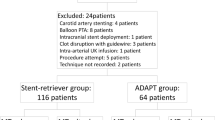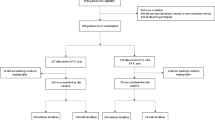Abstract
Background
There are little available data regarding the influence of intravenous thrombolysis (IVT) on the efficacy of different first line endovascular treatment (EVT) techniques.
Methods
We used the dataset of the SWIFT-DIRECT trial which randomized 408 patients to IVT + EVT or EVT alone at 48 international sites. The protocol required the use of a stent retriever (SR), but concomitant use of a balloon guide catheter (BGC) and/or distal aspiration (DA) catheter was left to the discretion of the operators. Four first line techniques were applied in the study population: SR, SR + BGC, SR + DA, SR + DA + BGC. To assess whether the effect of allocation to IVT + EVT versus EVT alone was modified by the first line technique, interaction models were fitted for predefined outcomes. The primary outcome was first pass mTICI 2c‑3 reperfusion (FPR).
Results
This study included 385 patients of whom 172 were treated with SR + DA, 121 with SR + DA + BGC, 57 with SR + BGC and 35 with SR. There was no evidence that the effect of IVT + EVT versus EVT alone would be modified by the choice of first line technique; however, allocation to IVT + EVT increased the odds of FPR by a factor of 1.68 (95% confidence interval, CI 1.11–2.54).
Conclusion
This post hoc analysis does not suggest treatment effect heterogeneity of IVT + EVT vs EVT alone in different stent retriever techniques but provides evidence for increased FPR if bridging IVT is administered before stent retriever thrombectomy.



Similar content being viewed by others
Abbreviations
- ESO:
-
European Stroke Organization
- EVT:
-
Endovascular treatment
- IQR:
-
Interquartile range
- IVT:
-
Intravenous thrombolysis
- mRS:
-
Modified Rankin scale
- MT:
-
Mechanical thrombectomy
- mTICI:
-
Post-interventional modified thrombolysis in cerebral infarction score
- NIHSS:
-
National Institutes of Health Stroke Scale
- SWIFT-DIRECT:
-
Solitaire with the intention for thrombectomy plus intravenous t‑PA versus DIRECT solitaire stent retriever thrombectomy in acute anterior circulation stroke
References
Zi W, Qiu Z, Li F, Sang H, Wu D, Luo W, et al. Effect of endovascular treatment alone vs intravenous alteplase plus endovascular treatment on functional independence in patients with acute ischemic stroke: the DEVT randomized clinical trial. JAMA. 2021;325(3):234–43. https://doi.org/10.1001/jama.2020.23523.
Yang P, Zhang Y, Zhang L, Zhang Y, Treurniet KM, Chen W, et al. Endovascular thrombectomy with or without intravenous alteplase in acute stroke. N Engl J Med. 2020;382(21):1981–93. https://doi.org/10.1056/NEJMoa2001123.
Suzuki K, Matsumaru Y, Takeuchi M, Morimoto M, Kanazawa R, Takayama Y, et al. Effect of mechanical thrombectomy without vs with intravenous thrombolysis on functional outcome among patients with acute ischemic stroke: the SKIP randomized clinical trial. JAMA. 2021;325(3):244–53. https://doi.org/10.1001/jama.2020.23522.
LeCouffe NE, Kappelhof M, Treurniet KM, Rinkel LA, Bruggeman AE, Berkhemer OA, et al. A randomized trial of intravenous alteplase before endovascular treatment for stroke. N Engl J Med. 2021;385(20):1833–44. https://doi.org/10.1056/NEJMoa2107727.
Fischer U, Kaesmacher J, Strbian D, Eker O, Cognard C, Plattner PS, et al. Thrombectomy alone versus intravenous alteplase plus thrombectomy in patients with stroke: an open-label, blinded-outcome, randomised non-inferiority trial. Lancet. 2022;400(10346):104–15. https://doi.org/10.1016/S0140-6736(22)00537-2.
Mitchell PJ, Yan B, Churilov L, Dowling RJ, Bush SJ, Bivard A, et al. Endovascular thrombectomy versus standard bridging thrombolytic with endovascular thrombectomy within 4·5 h of stroke onset: an open-label, blinded-endpoint, randomised non-inferiority trial. Lancet. 2022;400(10346):116–25. https://doi.org/10.1016/S0140-6736(22)00564-5.
Kaesmacher J, Mujanovic A, Treurniet K, Kappelhof M, Meinel TR, Yang P, et al. Perceived acceptable uncertainty regarding comparability of endovascular treatment alone versus intravenous thrombolysis plus endovascular treatment. J NeuroIntervent Surg. 2022; https://doi.org/10.1136/neurintsurg-2022-018665.
Turc G, Tsivgoulis G, Audebert HJ, Boogaarts H, Bhogal P, De Marchis GM, et al. European Stroke Organisation (ESO)–European Society for Minimally Invasive Neurological Therapy (ESMINT) expedited recommendation on indication for intravenous thrombolysis before mechanical thrombectomy in patients with acute ischemic stroke and anterior circulation large vessel occlusion. J NeuroIntervent Surg. 2022;14(3):209–27. https://doi.org/10.1136/neurintsurg-2021-018589.
Mokin M, Waqas M, Fifi JT, De Leacy R, Fiorella D, Levy EI, et al. Intravenous alteplase has different effects on the efficacy of aspiration and stent retriever thrombectomy: analysis of the COMPASS trial. J NeuroIntervent Surg. 2021; https://doi.org/10.1136/neurintsurg-2021-017943.
Shigeta K, Suzuki K, Matsumaru Y, Takeuchi M, Morimoto M, Kanazawa R, et al. Intravenous alteplase is associated with first pass effect in stent-retriever but not ADAPT thrombectomy. Clin Neuroradiol. 2022;32(1):153–62. https://doi.org/10.1007/s00062-021-01085-3.
Rinkel LA, Treurniet KM, Nieboer D, Kappelhof M, LeCouffe NE, Bruggeman AAE, et al. Effect of intravenous alteplase treatment on first-line stent retriever versus aspiration alone during endovascular treatment. Stroke. 2022. https://doi.org/10.1161/STROKEAHA.121.038390.
Kaesmacher J, Dobrocky T, Heldner MR, Bellwald S, Mosimann PJ, Mordasini P, et al. Systematic review and meta-analysis on outcome differences among patients with TICI2b versus TICI3 reperfusions: success revisited. J Neurol Neurosurg Psychiatry. 2018;89(9):910–7. https://doi.org/10.1136/jnnp-2017-317602.
Zaidat OO, Castonguay AC, Linfante I, Gupta R, Martin CO, Holloway WE, et al. First pass effect: a new measure for stroke thrombectomy devices. Stroke. 2018;49(3):660–6. https://doi.org/10.1161/strokeaha.117.020315.
Bourcier R, Saleme S, Labreuche J, Mazighi M, Fahed R, Blanc R, et al. More than three passes of stent retriever is an independent predictor of parenchymal hematoma in acute ischemic stroke. J NeuroIntervent Surg. 2019;11(7):625–9. https://doi.org/10.1136/neurintsurg-2018-014380.
Kaesmacher J, Maegerlein C, Kaesmacher M, Zimmer C, Poppert H, Friedrich B, et al. Thrombus migration in the middle cerebral artery: incidence, imaging signs, and impact on success of endovascular thrombectomy. J Am Heart Assoc. 2017; https://doi.org/10.1161/jaha.116.005149.
Kaesmacher J, Giarrusso M, Zibold F, Mosimann PJ, Dobrocky T, Piechowiak E, et al. Rates and quality of preinterventional reperfusion in patients with direct access to endovascular treatment. Stroke. 2018;49(8):1924–32. https://doi.org/10.1161/strokeaha.118.021579.
Alves HC, Treurniet KM, Jansen IGH, Yoo AJ, Dutra BG, Zhang G, et al. Thrombus migration paradox in patients with acute ischemic stroke. Stroke. 2019;50(11):3156–63. https://doi.org/10.1161/STROKEAHA.119.026107.
Fischer U, Kaesmacher J, Plattner P, Bütikofer L, Mordasini P, Deppeler S, et al. SWIFT DIRECT: solitaire™ with the intention for thrombectomy plus intravenous t‑PA versus DIRECT solitaire™ stent-retriever thrombectomy in acute anterior circulation stroke: methodology of a randomized, controlled, multicentre study. Int J Stroke. 2022. https://doi.org/10.1177/17474930211048768.
Mokin M, Primiani CT, Castonguay AC, Nogueira RG, Haussen DC, English JD, et al. First pass effect in patients treated with the trevo stent-retriever: a TRACK registry study analysis. Front Neurol. 2020; https://doi.org/10.3389/fneur.2020.00083.
Pop R, Finitsis SN, Arquizan C, Elhorany M, Naggara O, Darcourt J, et al. Poor clinical outcome despite successful basilar occlusion recanalization in the early time window: incidence and predictors. J NeuroIntervent Surg. 2022; https://doi.org/10.1136/neurintsurg-2022-018769.
Baek J‑H, Kim BM, Kang D‑H, Heo JH, Nam HS, Kim YD, et al. Balloon guide catheter is beneficial in endovascular treatment regardless of mechanical recanalization modality. Stroke. 2019;50(6):1490–6. https://doi.org/10.1161/STROKEAHA.118.024723.
Nguyen TN, Castonguay AC, Nogueira RG, Haussen DC, English JD, Satti SR, et al. Effect of balloon guide catheter on clinical outcomes and reperfusion in trevo thrombectomy. J NeuroIntervent Surg. 2019;11(9):861–5. https://doi.org/10.1136/neurintsurg-2018-014452.
Podlasek A, Dhillon PS, Jewett G, Shahein A, Goyal M, Almekhlafi M. Clinical and procedural outcomes with or without balloon guide catheters during endovascular thrombectomy in acute ischemic stroke: a systematic review and meta-analysis with first-line technique subgroup analysis. AJNR Am J Neuroradiol. 2021;42(8):1464–71. https://doi.org/10.3174/ajnr.A7164.
Blasco J, Puig J, López-Rueda A, Daunis-i-Estadella P, Llull L, Zarco F, et al. Addition of intracranial aspiration to balloon guide catheter does not improve outcomes in large vessel occlusion anterior circulation stent retriever based thrombectomy for acute stroke. J NeuroIntervent Surg. 2021; https://doi.org/10.1136/neurintsurg-2021-017760.
Maïer B, Finitsis S, Bourcier R, Papanagiotou P, Richard S, Marnat G, et al. First-line thrombectomy strategy for anterior large vessel occlusions: results of the prospective ETIS egistry. J NeuroIntervent Surg. 2022;14(5):450–6. https://doi.org/10.1136/neurintsurg-2021-017505.
Teo YN, Sia C‑H, Tan BYQ, Mingxue J, Chan B, Sharma VK, et al. Combined balloon guide catheter, aspiration catheter, and stent retriever technique versus balloon guide catheter and stent retriever alone technique: a systematic review and meta-analysis. J NeuroIntervent Surg. 2022; https://doi.org/10.1136/neurintsurg-2021-018406.
Acknowledgements
Academic investigators designed SWIFT-DIRECT. Susan Kaplan provided English language support.
Funding
Medtronic supported the study by an unrestricted grant to the University Hospital Bern without involvement in the final design, data analysis or interpretation. The University Hospital of Bern, Switzerland provided additional funding.
Author information
Authors and Affiliations
Consortia
Corresponding author
Ethics declarations
Conflict of interest
G. Marnat reports consulting fees from Stryker Neurovascular; paid lectures for Medtronic and Microvention Europe. M. Ribo reports consulting fees from Medtronic, Stryker, Cerenovus, Philips and Apta Targets; payment or honoraria from Ischemia View; Participation on a Data Safety Monitoring Board or Advisory Board of Sensome; stock or stock options in Anaconda Biomed, CVAid and Methinks. D.S. Liebeskind reports consulting fees from Cerenovus, Genentech, Medtronic, Stryker, Rapid Medical as imaging core laboratory. J. Gralla reports a Swiss National Funds (SNF) grant for MRI in stroke. U. Fischer reports financial support for the present study from Medtronic. SWIFT DIRECT is an investigator-initiated trial. The sponsor was not involved in the final study design, protocol, conduct, evaluation of results or preparation of the manuscript. U. Fischer also reports research grants from Medtronic BEYOND SWIFT registry, Swiss National Science Foundation, Swiss Heart Foundation; consulting fees from Medtronic, Stryker and CSL Behring (fees paid to institution); membership of a Data Safety Monitoring Board for the IN EXTREMIS trial and TITAN trial and Portola (Alexion) Advisory board (fees paid to institution); and Vice President of the Swiss Neurological Society. J. Kaesmacher reports financial support of Medtronic for the BEYOND SWIFT Registry (fees paid to institution); research grant from the Swiss National Science Foundation supporting the TECNO trial (fees paid to institution); Swiss Academy of Medical Sciences research grant supporting MRI research (fees paid to institution); Swiss Heart Foundation research grant supporting cardiac MRI in the etiological work-up of stroke patients (fees paid to institution). R. Pop, S. Räty, R. Riva, T. Dobrocky, P.L. Alexandre, M. Lefebvre, J.F. Albucher, M. Boulanger, F. Di Maria, S. Richard, S. Soize, E.I. Piechowiak, J. Liman, A. Reich, T. Meinel and A. Mpotsaris declare that they have no competing interests.
Additional information
Registration
URL: https://www.clinicaltrials.gov; Unique identifier: NCT03192332
The authors U. Fischer and J. Kaesmacher contributed equally to the manuscript.
Supplementary Information
Rights and permissions
Springer Nature or its licensor (e.g. a society or other partner) holds exclusive rights to this article under a publishing agreement with the author(s) or other rightsholder(s); author self-archiving of the accepted manuscript version of this article is solely governed by the terms of such publishing agreement and applicable law.
About this article
Cite this article
Pop, R., Räty, S., Riva, R. et al. Effect of Bridging Thrombolysis on the Efficacy of Stent Retriever Thrombectomy Techniques. Clin Neuroradiol 34, 93–103 (2024). https://doi.org/10.1007/s00062-023-01340-9
Received:
Accepted:
Published:
Issue Date:
DOI: https://doi.org/10.1007/s00062-023-01340-9




